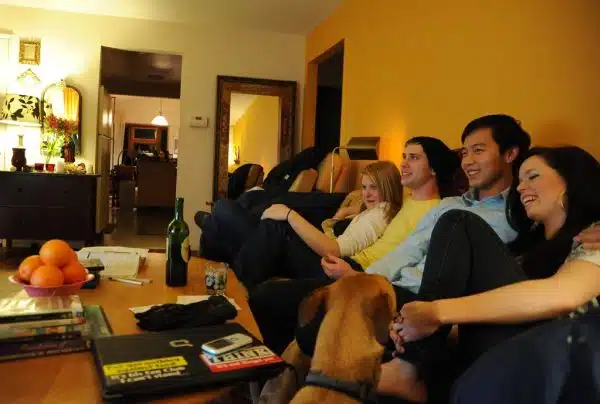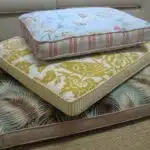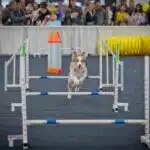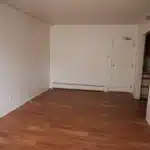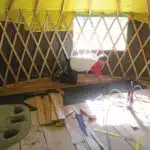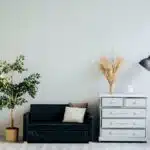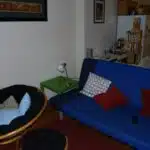The trend of dog rooms has been gaining popularity in recent years, especially among pet owners who wish to provide the best living conditions for their furry companions. Dog rooms are essentially designated spaces within a house that are solely dedicated to dogs, with amenities such as comfortable bedding, toys, and food bowls. But how did this trend come about? What led to the creation of these specialized rooms for dogs?
While there is no one clear answer to this question, it is believed that the growing awareness of the mental and physical health benefits of pets played a significant role in popularizing the idea of dog rooms. As more people began to understand the importance of providing adequate space and care for their pets, they started looking for ways to improve their homes to better suit their furry friends’ needs. This article aims to explore the history and evolution of dog rooms and shed light on how this relatively new concept has become an essential aspect of modern pet lifestyle.
The History Of Pet Ownership
Pet ownership has been a part of human culture for centuries, with historical evidence suggesting that humans began domesticating animals as early as the Neolithic era. As civilizations evolved, so did the ways in which they interacted with their pets. Cultural influences played a significant role in shaping pet ownership trends and traditions across different parts of the world.
Economic factors also had a considerable impact on pet ownership, particularly in the 19th century when people began to view pets as more than just working animals. As society became more affluent, people started keeping pets purely for companionship rather than practical purposes. This shift led to an increase in the demand for pet-related products and services, which further contributed to the evolution of pet ownership.
Today, pet ownership is deeply ingrained in many cultures worldwide. However, there are still significant variations in how different regions approach owning animals. Understanding these cultural nuances is crucial to comprehending why certain trends have emerged and how they continue to shape modern-day pet lifestyles. With this knowledge, we can explore how home design for pets has evolved over time and why concepts like dog rooms have become increasingly popular in recent years.
Understanding The Evolution Of Home Design For Pets
The concept of pet-friendly home design is not new. Americans have always been passionate about their pets and their comfort, so it was only a matter of time before designers began incorporating pet-friendly furniture in their designs. Pet-friendly furniture is designed to accommodate both pets and their owners by providing features like easy-to-clean fabrics, built-in pet beds, and storage solutions for toys and food.
One of the most popular trends in home design for pets is customizable dog spaces. These spaces can be anything from a small nook in the living room to a full-size room dedicated to dogs. Customizable dog spaces are designed with the needs of both dogs and owners in mind and can include features like built-in crates, feeding stations, and lounging areas. They provide dogs with a comfortable place to relax while also keeping them out of harm’s way.
As we continue to prioritize our furry friends’ comfort, the pet industry has seen an exponential rise in popularity over recent years. With more people opting for personalized home designs that cater to their pets’ needs, it’s no surprise that the pet industry has grown rapidly as well. From high-end pet accessories to customized dog spaces, it seems that the sky is the limit when it comes to designing homes that are both beautiful and functional for furry family members.
The Rise Of The Pet Industry
As pet owners continue to prioritize their furry friends, the pet industry has seen significant growth in recent years. This trend has led to an increase in pet pampering and a rise in the demand for luxury pet products. One of the latest trends in this industry is the creation of dog rooms, which have become a popular addition to many homes.
Dog rooms are designed specifically to cater to the needs of man’s best friend. These rooms are equipped with everything from comfortable beds and toys to specialized lighting and sound systems. Some even feature built-in showers or washing stations for easy clean-up after playtime. Pet owners who invest in these spaces often do so out of a desire to provide their pets with high-quality living conditions that promote physical and mental health.
The economic impact of this trend cannot be ignored. As more people invest in dog rooms and other luxury pet products, businesses catering to this market have seen increased revenue. From interior designers creating custom spaces for four-legged clients, to manufacturers producing high-end pet furniture, there is no shortage of opportunities for entrepreneurs looking to capitalize on the growing demand for luxury pet products. As we will explore further, the importance of mental and physical health for pets is driving this trend towards elevated living spaces for our furry friends.
The Importance Of Mental And Physical Health For Pets
Maintaining the mental and physical health of pets is crucial to their overall well-being. Pets, like humans, need to engage in regular exercise and activities that promote good health. Pet therapy is one way to ensure that pets remain healthy and active. This type of therapy involves using animals in a variety of settings to help people improve their mental and physical health.
In addition to pet therapy, pets also need access to exercise equipment that helps them stay active and healthy. Treadmills, agility courses, and other types of equipment provide pets with opportunities for physical activity. Regular exercise not only helps maintain a pet’s weight but also improves their cardiovascular health.
Overall, maintaining the mental and physical health of pets requires ongoing attention from pet owners. Providing access to pet therapy and exercise equipment are just two ways owners can support their pet’s well-being. By prioritizing these aspects of pet care, owners can ensure that their furry companions lead happy, healthy lives.
As more people recognize the importance of maintaining their pet’s health, there has been an emergence of pet-friendly homes. These homes are designed with features that cater specifically to the needs of pets. From built-in feeding stations to dog rooms equipped with exercise equipment and designated play areas, these homes prioritize the comfort and well-being of furry companions. In the next section, we will explore how this trend has developed over time and what it means for the future of human-pet relationships.
The Emergence Of Pet-Friendly Homes
As pet owners, we know that the health of our furry friends is just as important as our own. We make sure they exercise regularly, eat well, and keep up with their vet appointments. However, as our bond with our pets grows stronger, we find ourselves wanting to do more to ensure their happiness beyond the basics of physical health.
This has led to the emergence of pet-friendly homes that cater to the emotional needs of our four-legged companions. One such trend is the creation of dog rooms within homes. These are designated spaces where dogs can play, sleep and relax in a safe and comfortable environment. They often include amenities such as indoor dog houses, soft cushions or beds, toys and treats.
Pet friendly travel and dog-friendly workplaces have also contributed to this trend. As more people choose to take their pets on vacation or bring them into work with them, there is a growing need for accommodating spaces where pets can feel at home away from home. This has resulted in a rise in demand for hotels and offices that offer designated dog rooms for their guests or employees.
- The benefits of having a dog room in your home:
- Provides a safe space for dogs
- Helps reduce anxiety by giving dogs their own territory
- The impact of social media on promoting dog rooms:
- Inspires pet owners to create similar spaces for their furry friends
- Encourages businesses to incorporate pet-friendly amenities into their services
With the increasing popularity of dog rooms, it’s no surprise that social media has played a significant role in promoting this trend. Pet owners share pictures and videos of their furry friends enjoying these spaces online, which inspires others to create similar environments for their own pets. Additionally, businesses have taken notice of this trend and are incorporating pet-friendly amenities into their services as a way to attract customers who want to include their pets in all aspects of life.
The Role Of Social Media In Promoting Dog Rooms
The rise of dog rooms can be attributed to the impact of social media influencers. These pet owners, with their massive followings on platforms like Instagram and YouTube, have helped popularize the idea of creating designated spaces for dogs within homes. By sharing photos and videos of their own dogs in these specially designed areas, they have inspired others to do the same.
In addition to influencer impact, breed-specific dog room design has also played a role in this trend. Certain breeds require more space or specific amenities than others, such as a large play area for active dogs like border collies or a cozy nook for smaller breeds like chihuahuas. As pet owners become more aware of these needs, they are increasingly investing in customized spaces that cater to their furry friends.
Overall, the promotion of dog rooms through social media and tailored design options has led to a greater understanding of the benefits of giving dogs their own space within homes. From improved behavior to increased comfort and safety, designated areas for pets can enhance both their lives and those of their owners.
Transition: Now that we understand how social media and breed-specific design have contributed to the popularity of dog rooms, let’s explore some of the specific benefits these spaces can provide for our four-legged friends.
The Benefits Of Designated Spaces For Dogs
The Role of Social Media in Promoting Dog Rooms has undoubtedly played a significant part in the growing popularity of creating designated spaces for our furry friends. It’s not just about having a room for them to sleep in anymore; it’s about creating an environment that is specifically tailored to their needs, and social media has allowed pet owners to share their unique design ideas with each other.
Benefits
- Having a designated space for your dog can help create a sense of structure and routine in their lives, which can lead to a happier, well-behaved pup.
- A dog room can also provide an excellent place to store all of your pet’s essentials, such as food, toys, and grooming supplies.
- Designing a dog room can be an enjoyable creative outlet for pet owners who like DIY projects or interior design.
Design Ideas
- When designing your dog room, think about incorporating elements that will help keep your furry friend calm and relaxed. Soft lighting, calming colors, and comfortable bedding are all great options.
- Don’t forget about storage! Include shelves or cabinets where you can keep all of your pet’s belongings organized and easily accessible.
- Consider adding some fun elements to the space, like a wall-mounted water fountain or a built-in play area.
Creating a designated space for your dog may seem like an unnecessary expense or hassle at first glance. However, when considering the benefits it provides both you and your furry friend, it becomes apparent that it is worth the investment. In the subsequent section, we will explore some key features of a dog room that every pet owner should consider when designing one for their four-legged companion.
Key Features Of A Dog Room
Dog rooms have become increasingly popular in recent years due to the growing trend of pet ownership and the desire for pets to have their own designated space. These rooms are specifically designed with the needs and comfort of dogs in mind, incorporating a range of features that cater to their daily routines and habits.
One of the key features of a dog room is ample space for movement and play. Dogs need plenty of room to stretch their legs, run around, and play with their toys. Therefore, a spacious area with plenty of natural light and ventilation is ideal. Additionally, dog owners can install soft flooring materials like rubber or cork to provide a comfortable surface for dogs to walk on.
Another important feature is storage for all the necessary items that come along with owning a dog. This includes food bowls, leashes, toys, grooming supplies, and more. Built-in cabinets or shelving units can be installed to neatly organize these items while keeping them easily accessible for the owner.
Design trends for dog rooms continue to evolve as pet owners seek out creative ways to make these spaces both functional and aesthetically pleasing. Some popular design ideas include incorporating colorful murals or wallpaper featuring dog-related imagery, installing custom-built kennels or crates that blend seamlessly into the room’s design, or adding decorative elements like framed photos or artwork showcasing beloved pets.
As you begin planning your own dog room, consider incorporating some of these key features and design trends into your space. With careful consideration and attention to detail, you can create a comfortable retreat where your furry friend can relax and feel right at home.
Design Ideas For Your Own Dog Room
Creating an inviting, comfortable and functional space for your pet can be a great way to show your love for your four-legged friends. When creating a dog room, it is important to consider how to best optimize the space for your pet’s needs. Additionally, choosing the right furniture for the room can be key to creating an inviting, comfortable atmosphere for your pup. From dog beds to couches, there are a variety of options that can help you create the perfect room for your pup.
Optimizing Space
Designing a dog room is not just about pampering our furry friends, it is also about maximizing functionality and optimizing space. One key element to consider when creating a dog room is the efficient use of space. Since not all homes have ample space for a dedicated dog room, space-saving techniques can be implemented to ensure that the area remains functional yet does not take up too much floor space.
One technique for optimizing space in a dog room is by utilizing wall-mounted shelves or cabinets. This allows for storage of pet supplies such as toys, treats, and food without taking up valuable floor space. Additionally, incorporating foldable furniture such as collapsible dog beds or wall-mounted feeding stations can create more open floor space when not in use.
Another way to optimize space in a dog room is by designing versatile pieces of furniture. For instance, multipurpose benches can double up as storage spaces while providing seating for both humans and pets. Custom-built drawers with built-in feeding bowls or beds can also be installed under staircases or other unused spaces. These designs are perfect for homeowners who want to dedicate some areas for their furry friends while still maximizing their living spaces.
Overall, designing a functional and stylish dog room requires creativity and careful consideration of available spaces. By implementing various techniques such as wall-mounted shelves, foldable furniture and versatile pieces of furniture into the design process, homeowners can create unique dog rooms that are both comfortable for pets while remaining practical for their owners’ needs.
Furniture Choices
When it comes to designing a dog room, one important aspect to consider is furniture choices. The right furniture can make a huge difference in both the functionality and aesthetic appeal of the space. To start, pet owners should consider investing in multi-functional pieces such as storage ottomans or benches, which can double as seating for humans and provide storage for pet supplies. This is especially important for those with limited space who are looking to maximize their floor area.
Another furniture choice that can optimize space is elevated dog beds. These types of beds not only provide a comfortable sleeping spot for dogs but also free up floor space below them. This extra space can be used for additional storage or even a small play area for dogs. Plus, elevated dog beds come in many different styles and materials, making them versatile enough to fit into any dog room decor.
Lastly, when selecting furniture for a dog room, homeowners should keep in mind the durability of their chosen pieces. Dogs can be tough on furniture, so investing in high-quality pieces that will last over time is crucial. Additionally, pet owners may want to look for furniture made from materials that are easy to clean and maintain, as this will help keep the space looking fresh and tidy.
By carefully considering their furniture choices and selecting multi-functional pieces like storage benches and elevated dog beds, homeowners can create stylish yet practical dog rooms that make the most of available space while providing comfort and convenience for their furry friends.
How To Incorporate Dog Rooms Into Your Home
Just like how humans require their own space to relax and unwind, dogs also need a designated area that they can call their own. This is where custom dog rooms come into play – a space where your furry friend can have some alone time and feel comfortable. Incorporating a dog room into your home not only benefits your pet but also adds value to your property.
When it comes to designing your dog room, there are plenty of options to choose from. Custom furniture such as built-in dog beds or elevated feeding stations are great additions that can save you floor space while keeping everything in one place. For flooring options, consider using durable materials like concrete, tile, or vinyl that are easy to clean and withstand accidents. Decorating ideas such as colorful paw-printed wallpaper or framed photos of your furry friend will add a personal touch to the room.
Storage solutions are also crucial when it comes to incorporating a dog room into your home. Including shelves or cabinets for storing food, treats, toys, and grooming supplies will keep the room organized and clutter-free. A three-item numeric list in markdown format below highlights additional ideas on how you can make the most out of your dog room:
- Make sure there is adequate ventilation in the room
- Install proper lighting for nighttime use
- Add an indoor/outdoor rug for additional comfort
Overall, creating a dog room is an investment worth making if you want to provide the best possible living conditions for your pet while also adding value to your home. In the next section, we will discuss the cost of building a custom dog room and what factors come into play when determining the price.
The Cost Of Building A Dog Room
The construction of a dog room can involve an array of materials, from wood to plastic, and the cost of these materials may vary. When taking into account labour costs, one should consider the amount of time and skill required to properly build a dog room. From installing walls to painting and decorating, the cost of labour can vary depending on the size of the room and the complexity of design. Therefore, the cost of building a dog room may depend on a combination of the materials and labour required to construct the space.
Materials
When it comes to building a dog room, choosing the right materials can be crucial. Not only do we want to create a comfortable and safe environment for our furry friends, but we also want to make sure that the materials used are eco-friendly and cost-effective. One option for eco-friendly materials is bamboo flooring. This material is not only durable and easy to clean, but it’s also renewable and sustainable. Another option is recycled rubber flooring, which is made from old tires and provides cushioning for dogs’ joints.
Cost-effective options for building a dog room include using PVC pipes to create a frame for the walls and ceiling. This material is affordable and lightweight, making it easy to install. For insulation, recycled denim can be used instead of traditional fiberglass insulation. This material not only insulates well but also absorbs sound, making it perfect for a quiet dog room.
Overall, when building a dog room, it’s important to consider both the comfort of our pets and the impact on the environment. By using eco-friendly materials such as bamboo or recycled rubber flooring, as well as cost-effective options like PVC pipes and recycled denim insulation, we can create a space that benefits both our furry companions and the planet.
Labour Costs
When it comes to building a dog room, one of the major factors that affect the cost is labour. Hiring skilled workers can be expensive, but there are ways to reduce labour costs without compromising the quality of the construction. One way to do this is by optimizing the construction process. By planning ahead and breaking down tasks into smaller, manageable steps, workers can work more efficiently and complete tasks faster.
Another way to reduce labour costs is by doing some of the work yourself. While hiring professionals for certain aspects of construction such as electrical and plumbing is highly recommended, there are other tasks that can be done by pet owners themselves with a little effort and research. For example, painting walls or installing flooring can be done by pet owners who have some DIY skills and tools.
In addition to optimizing the construction process and doing some DIY work, another way to reduce labour costs is by using prefabricated materials or pre-built structures. These materials are designed for easy assembly and installation, which means less time spent on construction and lower labour costs. However, it’s important to make sure that these materials meet safety standards and are appropriate for your dog’s needs before incorporating them into your dog room design.
Diy Vs. Professional Dog Room Construction
The cost of building a dog room can be quite expensive, which is why many pet owners are opting to create their own DIY dog rooms. Not only does this save money, but it also allows for more customization and personalization. However, before embarking on a DIY project, there are some important tips to keep in mind.
Firstly, it’s important to consider the layout and design of the room. It should be spacious enough for your dog to move around comfortably, with plenty of natural light and ventilation. Additionally, choosing durable materials that can withstand wear and tear from your furry friend will ensure that your DIY dog room lasts for years to come.
On the other hand, professional construction may be preferred by those who lack the necessary skills or time to complete a DIY project. Professional contractors have experience in designing and constructing dog rooms that meet specific requirements such as noise reduction and insulation. However, it’s important to consider the costs associated with this option as they can vary greatly depending on location and complexity of the project.
When deciding between a DIY or professional dog room construction, it ultimately comes down to personal preference and budget constraints. Regardless of which option you choose, careful planning and consideration must be taken into account to ensure that your furry friend has a safe and comfortable space within your home. In the next section, we’ll discuss common mistakes that pet owners make when building their own dog rooms so you can avoid them during your own project.
Common Mistakes To Avoid When Building A Dog Room
When considering how to create a comfortable and fun space for your pup, it is important to be mindful of the common mistakes that can be made. Overestimating size for the space can lead to wasted resources or an overcrowded room. Poor ventilation can be detrimental to the health and safety of your pup and can even lead to moisture damage over time. Unsuitable flooring can be uncomfortable and hazardous to your pup’s paws, so it is important to research and select flooring that is appropriate for the space. Additionally, selecting materials that are chew-proof and easy to clean is also recommended. In order to create a safe and enjoyable environment for your pup, it is advised to carefully consider all factors when designing their new space.
Overestimating Size
Dog rooms have become increasingly popular as more pet owners acknowledge the importance of creating a comfortable space for their furry friends. However, building a dog room is not an easy task and requires careful planning to avoid common mistakes. One of these mistakes is overestimating the size of the dog room.
Overestimating size is a common mistake when building a dog room, which can lead to unnecessary expenses and wasted space. Pet owners often have high expectations for the size of the room, thinking that their furry friend needs plenty of space to move around. However, downsizing expectations could be beneficial as dogs do not require much space to feel comfortable. A smaller dog room will also make it easier to maintain cleanliness and orderliness.
When building a dog room, it is essential to consider your pet’s size, breed, and habits. Some dogs may prefer cozy spaces while others may need more room to roam around. Therefore, it is crucial to observe your pet’s behavior and preferences before deciding on the size of the room. Downsizing your expectations will help you create a perfect living environment for your furry companion without wasting valuable resources or sacrificing your home’s functionality.
In conclusion, overestimating size is one of the common mistakes that pet owners make when building a dog room. Downsizing your expectations based on your pet’s habits and preferences will help you create a comfortable living environment without wasting valuable resources or compromising on functionality. By considering these factors when designing your dog’s living space, you can ensure that they have everything they need to stay happy and healthy in their new home.
Poor Ventilation
Proper ventilation is a crucial factor to consider when building a dog room, yet it is often overlooked. Poor ventilation systems can lead to various health concerns for both pets and humans. When designing your dog’s living space, it is essential to prioritize adequate airflow to ensure that your furry friend breathes clean air.
Without proper ventilation, the air in the dog room can become stagnant and contaminated with dust, dander, and other pollutants that can irritate your pet’s respiratory system. This could lead to health issues such as allergies, respiratory infections, or even chronic conditions like asthma. Additionally, poor ventilation can also affect human health. Pet owners who spend time in poorly ventilated rooms may experience symptoms such as headaches, eye irritation, or coughing.
To avoid these health concerns, it is crucial to invest in a good quality ventilation system when building a dog room. Proper airflow will help remove pollutants and provide fresh air for your pet and yourself. An efficient exhaust fan or HVAC system will keep the air circulating while removing odors and moisture from the room. By prioritizing good ventilation during the design process of your dog’s living space, you can create a healthy environment that promotes their well-being.
Unsuitable Flooring
When designing a dog room, there are many factors to consider, including proper ventilation, lighting, and furniture. However, one aspect that should not be overlooked is the flooring. Choosing the wrong type of flooring can lead to health hazards for both pets and humans.
Pet friendly flooring is essential when building a dog room. Hardwood floors may look beautiful, but they are not suitable for dogs as they can scratch and become damaged easily. Additionally, hardwood floors are slippery and can cause injuries to your pet if they slip and fall. On the other hand, carpeted floors are difficult to clean and can harbor bacteria and allergens that may trigger allergic reactions in both pets and humans.
One solution is to opt for pet-friendly flooring options such as vinyl or tile. Vinyl flooring is easy to clean and resistant to scratches, making it an excellent choice for high traffic areas like dog rooms. Tile flooring is also durable and easy to clean; however, it may be slippery when wet, so it’s important to choose a textured tile or add a non-slip mat underneath.
In conclusion, choosing the right type of flooring for your dog room is crucial in promoting the health and safety of both pets and humans. By opting for pet-friendly options such as vinyl or tile flooring over hardwood or carpeted floors, you’ll ensure a comfortable living space for your furry friend while keeping their environment free from health hazards.
Maintaining And Cleaning Your Dog Room
Now that your dog room is set up, it is essential to keep it clean and organized. Maintaining a clean dog room not only benefits your furry friend but also helps maintain the overall cleanliness of your home. It is crucial to choose the right flooring options that are easy to clean and durable enough to withstand the wear and tear of your pet’s claws. Opt for materials like ceramic tiles or vinyl flooring, which are non-porous and stain-resistant.
Organization tips are key when it comes to maintaining a tidy dog room. Keep all toys, food bowls, leashes, and other accessories in designated spots so that they don’t clutter up the space. Use storage bins or shelves to store extra supplies like food bags or grooming equipment out of sight but within reach. Regularly dispose of waste in a sealed container and keep cleaning supplies nearby for quick cleanups.
In summary, keeping your dog room spotless requires consistent attention to detail. Flooring options should be chosen based on durability and ease of cleaning, while organization tips can help maximize available space. By following these simple maintenance guidelines, you can ensure that your furry friend enjoys a comfortable living space while minimizing any mess or odors in your home.
As more pet owners embrace the concept of dedicated dog rooms, innovative design trends are emerging. From high-tech air purifiers to custom-built play areas, these new features aim to enhance both the aesthetic appeal and functionality of dog rooms. In the next section, we’ll explore some exciting innovations that may inspire you as you continue to create the perfect space for your furry friend.
The Future Of Dog Rooms: Trends And Innovations
The future of dog rooms is looking brighter than ever before, with trends and innovations that cater to the needs of both pets and pet owners. One of the most exciting trends is the use of pet-friendly technology in designing dog rooms. For example, many dog rooms now come equipped with automatic feeders and water dispensers that can be controlled remotely via a smartphone app. This means pet owners can monitor their dogs’ feeding and hydration even when they’re away from home.
Another trend in dog room design is the use of sustainable materials. As people become more environmentally conscious, there’s a growing demand for eco-friendly products that minimize our impact on the planet. In response to this trend, many designers are incorporating recycled materials into their dog room designs. For example, some dog rooms now feature walls made from repurposed wood pallets or flooring made from recycled rubber.
With all these exciting developments in dog room design, it’s clear that pet owners have never had more options for creating comfortable, functional living spaces for their furry friends. Whether you’re looking for high-tech features or eco-friendly materials (or both!), there’s a dog room out there that meets your needs. So why not invest in a stylish and functional space for your pup today? Your furry friend will thank you!
Conclusion
The history of pet ownership has certainly undergone a significant transformation over the years, with pets now being considered members of the family in many households. This shift has led to a new trend in home design: the creation of dog rooms. As pet owners increasingly prioritize their furry friends’ physical and mental health, they are seeking ways to provide them with dedicated spaces for play, rest, and relaxation.
The rise of the pet industry has provided pet owners with an abundance of resources for creating these dog rooms. Whether building DIY or seeking professional help, there are common mistakes to avoid and maintenance tips to keep in mind. Looking to the future, it seems likely that trends and innovations will continue to emerge as more people prioritize the comfort and well-being of their beloved pets. As the old adage goes, “a happy dog means a happy home.” With dog rooms becoming more popular than ever before, it’s clear that pet owners are taking this sentiment to heart.
Image Credits

